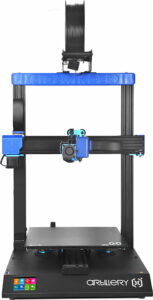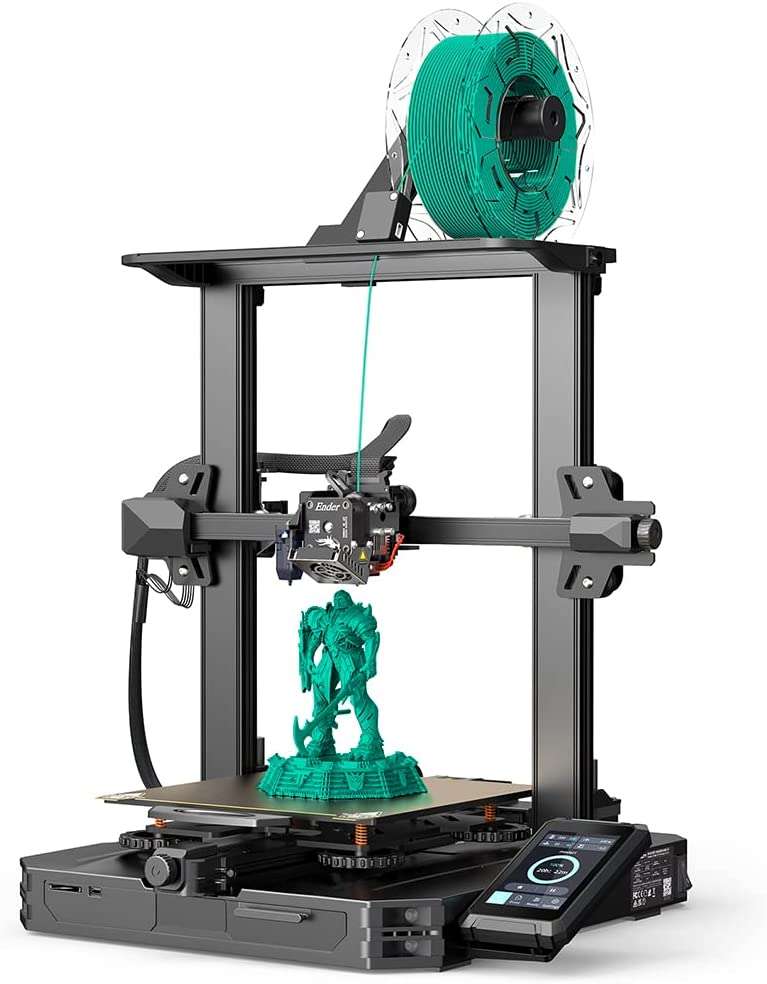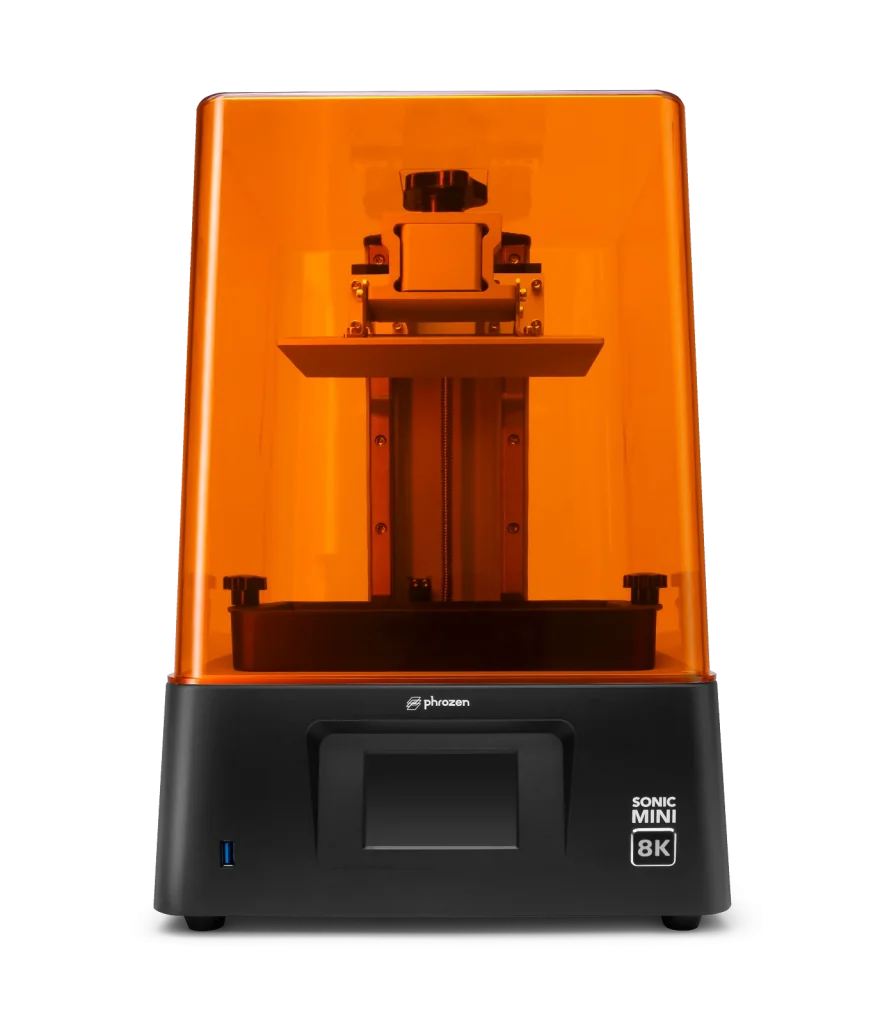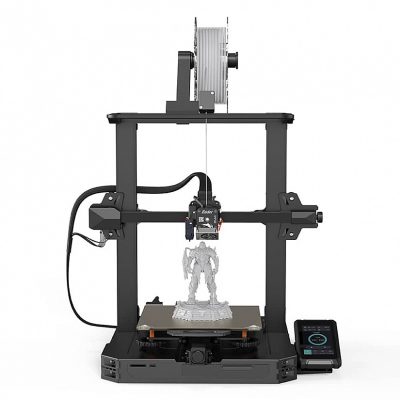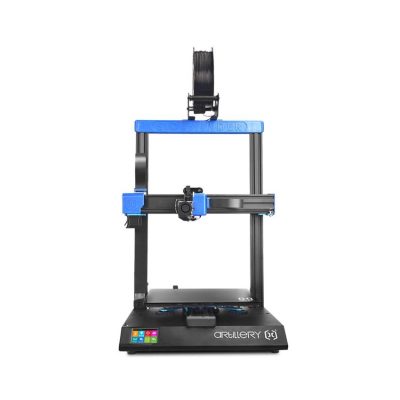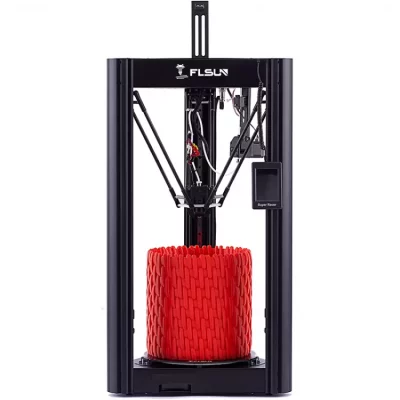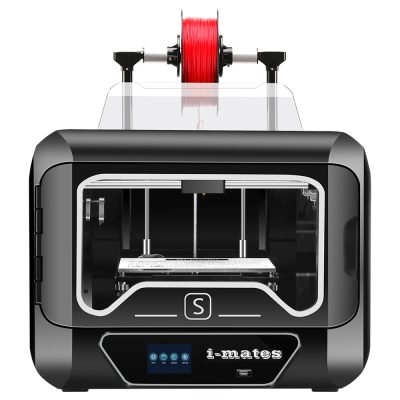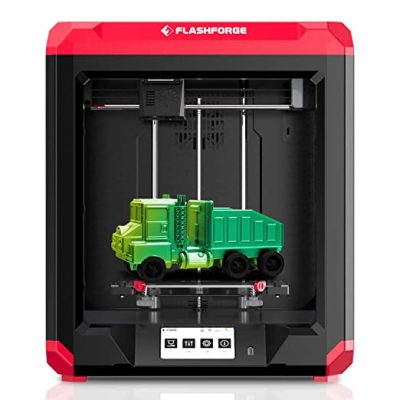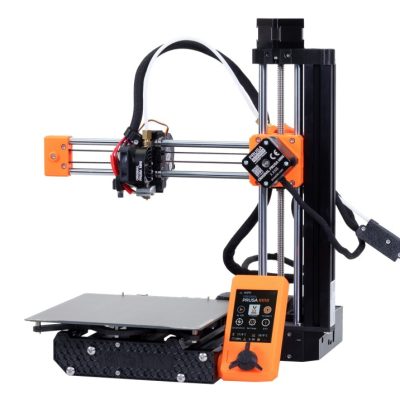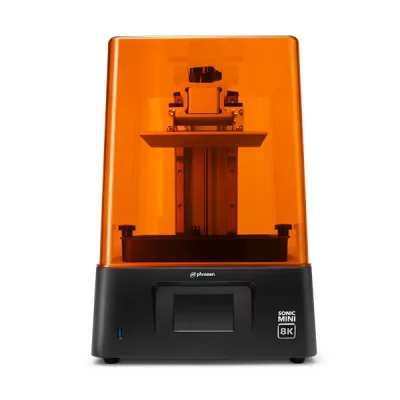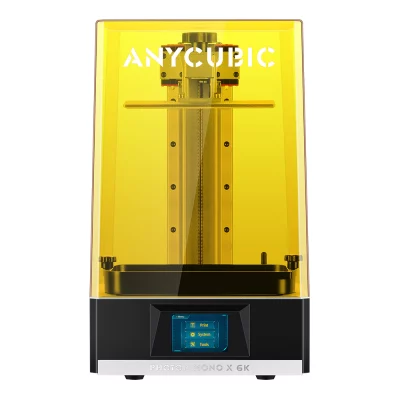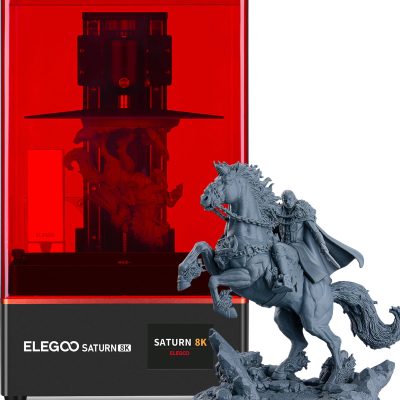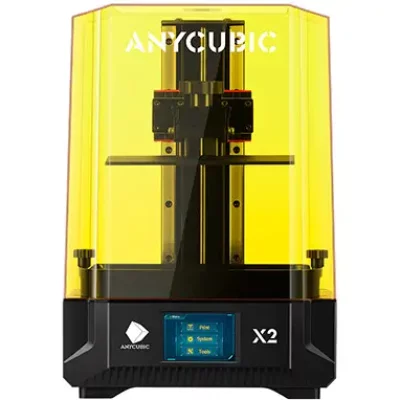- Last Updated: January 12, 2024
-
 Pat Nathaniel
Pat Nathaniel
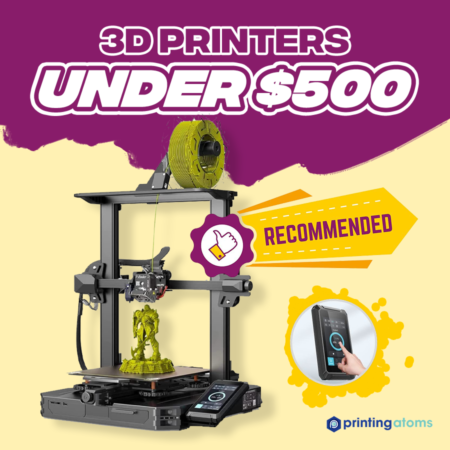 Looking for the best 3D printer under $500?
Looking for the best 3D printer under $500?
We have just the ticket here in our clever guide.
Though they’ve been around for a couple of decades now, 3D printers have only just reached the point where the average Joe can own his own.
After all, for many years, these machines were far too large and too expensive to fit into someone’s home or office setup.
But that’s no longer the case!
As you’ve seen in our other list, there are plenty of 3D printers out there for less than $1000, putting them within a reasonable price range for serious hobbyists and creators.
Still, that kind of money is definitely pushing it for people who aren’t yet invested in the field. $700-800 is still a chunk of change for someone who isn’t sure about the whole 3D printing concept, much less ready to dive in headfirst.
What if you could go even lower?

Build Volume: 300 x 300 x 400 mm

Build Volume: 220 x 220 x 270 mm

Build Volume: 165 x 72 x 180 mm
Top 3D Printers Under $500 At A glance
II’ll be taking a look at some of the top 3D printers on the block, all of which cost less than $500. From there, you can figure out which will be best for your needs – whether you’re giving it as a present, looking to upgrade from your first affordable 3D printer under $300, or hoping to kickstart your 3D printing operation, or just trying to find out what all the fuss is about.
Let’s get started!
FDM
1. Creality Ender 3 S1 Pro (Best Choice)
2. Artillery Sidewinder X2 (Best Value)
3. FLSUN Super Racer (Best for Speedy Printing)
4. Qidi Tech i-Mate S (Best Budget)
5. Flashforge Finder 3 (Best for Educational Use)
6. Prusa Mini+ (Best for Miniature 3D Printer)
Resin
7. Phrozen Sonic Mini 8K (Premium Choice)
8. Anycubic Photon Mono X 6K (Best Large Resin Printer)
9. Elegoo Saturn 8K (Best Mid-Sized Resin Printer)
10. Anycubic Photon Mono X2 (Best Resin Printer for Beginners)
FDM
Build volume: 220 x 220 x 270 mm | Layer Resolution: 0.1 to 0.4 mm | Filament type: PLA, ABS, PVA, Wood, TPU90-95, PA, PETG | Print Speed: 150 mm/s | Printing Software: Creality Slicer
Looking for a reliable, printer that delivers good results nearly every time? The Creality Ender 3 S1 is a well-constructed FDM 3D printer that performs well with a consistently high-quality output — and in our opinion, the best 3D printer in the $500 price range.
It comes with a 300°C brass nozzle that allows you to print a huge variety of filaments, so if you like to experiment with different types, you’re in luck. And most printers on this list don’t have such flexibility, as their nozzles don’t support higher temperatures.
The Creality Ender 3 S1 Pro comes with a direct extruder, unlike other Ender printers’ Bowden-style extruder. With a direct extruder, you can print flexible filament like TPU and easily load filament without dealing with the potential hassles of Bowden-style extruders.
Nice!
Also, this 3D printer has the option for silent printing and automatic bed leveling, which are both awesome if you want to preserve your sanity. (Not many 3D printers come with sanity-preserving features.)
As is common for a lot of Creality 3D printers, the Ender 3 S1 Pro comes with a spring-steel PEI magnetic build plate, which is flexible and removable. It adheres amazingly to prints, but also makes it easy to remove them. All you have to do is bend the plate, and the print pops right off.
Pros
- Automatic bed leveling
- Direct extruder to print variety of filaments
- Removable build plate for easy print removal
- Silent printing
Cons
- No touchscreen
Build volume: 300 x 300 x 400 mm | Layer Resolution: 0.1 mm | Filament type: PLA, ABS, wood, HIPS, PVA, and flexible filaments | Print Speed: 150 mm/s | Printing Software: Cura, Simplify3D, Slic3r
The Artillery Sidewinder X2 is an FDM 3D printer that allows you to print with a huge variety of flexible filaments.
It has a build volume of 300 x 300 x 400 mm and a Direct Drive extruder — so if you’re looking to make bigger prints with flexible filaments, this 3D printer is perfect for you!
It delivers highly accurate and precise models with a layer resolution of just 0.1 mm thanks to its dual Z-axis design that allows for (mostly) robust and jitter-free printing. However, this seems to work only on smaller models, which end up looking nice and detailed — while large models can potentially be affected by Z-wobble (a shaky frame that causes minor print artefacts).
Unlike the silicone beds of previous models such as the X1, the Artillery Sidewinder X2 features a ceramic bed to achieve more consistent and faster print bed heating.
The X2 also comes with an auto bed leveling feature which automatically adjusts the print bed prior to any prints. This ensures nothing messes up your print at the last minute. Also, the print bed can heat up to 110°C within 2 minutes.
Also, the X2, like many other printers, has the filament run out/power failure sensor, and it can easily resume prints from exactly where they stopped — which is really handy if you live somewhere with a lot of power outages.
It comes with ultra-quiet stepper drivers to reduce the migraines that are often a side effect of loud and noisy 3D printing.
All-in-all, the Sidewinder X2 is the best large 3D printer on our list and amazing value for what you get.
Pros
- High-quality printing for smaller models
- Direct extrusion for printing flexible filaments
- Auto bed leveling feature
- Filament run out sensor
Cons
- Prone to Z-wobble on larger models
Build volume: 260 x 260 x 330 mm | Layer Resolution: 0.005 mm | Filament type: PLA, ABS, PETG | Print Speed: 200 mm/s | Printing Software: Cura
Want a 3D printer that’s built for speed? Look no further than the FLSUN Super Racer.
It’s a Delta 3D printer with a sturdy build and a decently large printing area. You can expect excellent detailing with an accuracy of just 0.01 mm. It also offers silent printing, which is great if you plan to print at home.
With a removable print bed, you can easily bend it and the print snaps right off! No more messing around with scrapers and hairspray. (We have bad memories of those.)
With a crazy 200 mm/s speed, you’re bound to churn prints out fast. And you won’t sacrifice any precision either — with a robust linear rail guide, you’re gonna get stability and not much printing noise. This printer also comes with automatic bed leveling and resume print function.
FLSUN offers quick and responsive tech support within 24 hours, so it’s also a plus to keep in mind whenever you run into any issues.
The Super Racer is our fastest 3D printer on this list and our #1 recommendation if speed is your middle name.
Pros
- Detailed prints
- Amazingly fast speed at 200 mm/s
- Removable print bed
- Good tech support
Cons
- Delta printers are generally less used so it may be difficult to find community support for problems you encounter
Build volume: 260 x 200 x 200 mm | Layer Resolution: 0.05 mm | Filament type: PLA, ABS, TPU, PETG | Print Speed: 150 mm/s | Printing Software: Cura
If you want bang for your buck, the Qidi Tech i-Mate S is your mate! (I know, terrible.) It’s an FDM printer with a robust enclosed structure and a sizable printing area.
What sets this apart from other printers on the list is its layer thickness of just 0.05 mm, which allows for fine detail on your prints at a super affordable price.
Also, its print bed can reach 120 degrees Celsius, which is perfect for high-temperature filaments. So if you want to print with TPU and the like, this printer will do it for you. (Not all by itself, obviously. No autonomous 3D printers for the general public yet!)
Unfortunately with this printer, you’ll need to level the bed yourself, so keep that in mind before you buy.
Other than that, though, it’s definitely worth buying for its reliable and sturdy design and its ease of use. This is a printer you can truly use right out of the box without needing to assemble anything.
Also, it comes with two extruders — one 0.4 mm extruder and one 0.2 mm extruder. This is for printing different types of filaments at different speeds and is a pretty thoughtful inclusion considering most 3D printer manufacturers only provide one extruder.
It also has a large UI interface which makes it super easy to work with. In its slicer, you can choose between normal and expert modes. Normal mode features already-tweaked and set parameters, while expert mode is for… well, experts!
Pros
- High level of detail in prints
- High-temperature filament capabilities
- Decent printing space
- Normal and expert slicing modes
- Comes with two extruders
Cons
- Manual bed leveling
Build volume: 190 x 195 x 200 mm | Layer Resolution: 0.1 to 0.4 mm | Filament type: PLA, ABS, HIPS, PETG, PETG PRO, TPU 95A | Print Speed: 180 mm/s | Printing Software: FlashPrint Slicer
Are you a teacher or a parent who wants a 3D printer to use in an educational context? The Flashforge Finder 3 is perfect for kids and 3D printing newbies. It works right out of the box and it’s got a bright and responsive touchscreen.
It also comes with multiple print beds — one glass and one PEI (flexible), so you can switch depending on the filament you’re printing. Or if you need to print something else straightaway, just swap the beds and you’re good to go.
This printer also has pretty decent print quality and comes with built-in WiFi capabilities. We didn’t much like the lack of enclosure panels, which would kind of be expected in a 3D printer geared towards kids, but for this price, it’s pretty decent in all other categories.
Also, it has a really cool looking red and black combination — we find that the aesthetics of 3D printers are often ignored or overlooked, but the FlashForge Finder 3.0 does look nice and can really brighten up a workspace.
It requires no assembly, so you don’t have to worry about putting together any parts or anything like that. It also detects filament running out and can save print progress when there is a power outage.
Thanks to its direct drive extruder, you’re gonna get smoother filament feeding. Also, the temperature can heat up to 260 degrees Celsius, which allows you to print TPU, HIPS, PETG, etc. So if you want to try out lots of filaments, this printer will allow you to do that.
It also comes with a 12 month warranty, lifetime technical assistance and customer service that’s available round the clock. Doesn’t sound too bad to us!
Pros
- Pretty good print quality
- Multiple print beds
- Easy-to-use touchscreen
Cons
- No enclosure
Build volume: 180 x 180 x 180 mm | Layer Resolution: 0.05-0.25 mm/s | Filament type: ABS / PLA / ASA / PETG / Flex | Print Speed: 200mm/s | Printing Software: Cura, Repetier-Host
Prusa has made its name as the gold standard for modern 3D printing technology, and there’s a good reason for that.
Their Original Prusa, in fact, is one of my favorite printers of all time, though it’s much too expensive to make it on this list. Luckily for all of us, their miniature version of the Original does fall below the $500 threshold.
This printer has a lot to offer, despite its considerably smaller build area. It’s a very quick printer, able to handle up to 200 mm/s, which I always favor for anyone interested in longer print projects.
Another great advantage of the Prusa Mini is its ability to handle a wide variety of different filaments (ABS / PLA / ASA / PETG / Flex), which gives you the option to handle a ton of different projects.
Pros
- Excellent speed
- Great filament versatility/options
- Small, compact size
Cons
- Small build area
- Expensive for its size
Resin
Build volume: 165 x 72 x 180 mm | Layer Resolution: 0.01 – 0.30 mm | Filament type: Resin | Print Speed: 80 mm/hr | Printing Software: ChiTuBox v1.9.0 or above
Are you looking for the best-quality print resolution available to consumers? The Phrozen Sonic Mini 8K is a mini beast of a printer, offering 8K detail with 7500 x 3240p resolution.
This high resolution yields some crazy intricate designs and if you’re really into super-detailed figurines, we can recommend no better 3D printer than this.
We highly recommend using Phrozen’s 8K resin, which yields spectacular detail and print quality that other resins would not show as much.
It comes prebuilt and you can use it almost immediately right out of the box — however, you will need to level the bed yourself. Do consider also that the LCD comes unprotected (a huge oversight on Phrozen’s part, we believe), so if you can, buy a screen protector as resin spills happen all the time — and then you’ll need another LCD, which is a pain in the backside.
Thanks to its stable dual linear rails, you won’t get much, if any, Z-wobble with this printer. No Z-wobble means no layer lines or other odd artifacts that can really mess up your print or make it look a little weird.
It also comes with a frosted laser-cut build plate (no, not that kind of frosted!) that allows prints to attach firmly and securely onto the build plate.
Pros
- Unprecedented resolution and detail
- Hassle-free printing
- Build plate that prints can securely attach to
- Stable dual linear rails
Cons
- Doesn’t come with a LCD screen protector
Build volume: 245 × 197 × 122 mm | Layer Resolution: 0.034 mm | Filament type: Resin | Print Speed: 80 mm/hr | Printing Software: Photon Workshop
Do you want a high level of detail like the Phrozen Sonic Mini 8K offers, but want something a bit bigger?
The Anycubic Photon Mono X 6K is the best large resin 3D printer on our list. It delivers 6K resolution with a huge build area so you can churn out all the giant Warhammer figurines and garden gnomes you want.
With a 9.25” LCD screen (that comes with a replaceable anti-scratch film), you can print larger objects with more detail. It has a matrix of 40 super bright LED lights that provide a lot of exposure to each layer of print.
Thanks to this LCD and matrix of lights, it offers super exact and accurate detailing — and is pretty easy to set up and start using. All you have to do is set up the print bed, level it, and you’re good to go!
However, we did find it to be annoyingly loud… so do consider printing yourself some earplugs once you get this 3D printer.
Pros
- Large build area
- 6K resolution and super accurate prints
Cons
- Loud fan noise
Build volume: 219 x 123 x 210 mm | Layer Resolution: 0.01 – 0.2 mm | Filament type: Resin | Print Speed: 70 mm/hr | Printing Software: ChiTuBox
If you’re looking for 8K resolution coupled with a decent build area, this printer is it! I love using this printer for miniatures & small models and printing jewelry.
The Elegoo Saturn 8K offers an XY accuracy of a miniscule 0.0285 mm thanks to its 10” 8K screen. You can print super sharp models that have an exposure time of only 1 to 3 seconds per layer — which is pretty fast considering how slow resin 3D printers can be.
Also, a big plus that other printers on this list don’t have — it has a simple two-bolt bed leveling process unlike the usual four bolts. With a two-bolt system, it’s much easier to get the bed leveling right the first time and avoid any problems later on.
It comes pre-assembled and it’s pretty easy to start printing with it. Also, unlike the Phrozen printer, it actually comes with a glass screen protector so you don’t have to worry about buying one yourself or permanently damaging your LCD. No shade, Phrozen, but Elegoo definitely wins in the screen protector category.
However, we did find that the resin vat has no spout, which is kind of a hassle when it comes to changing resin.
Thanks to its large build area, you can print medium to larger-sized figurines and models, or just print a whole lot of stuff at once! This is really useful because no one wants to waste resin, which is particularly expensive — much more so than filament. So by printing a whole batch of stuff at once, you can avoid the need to constantly refill the vat.
It also comes with a USB-powered purifier featuring activated carbon that absorbs and filters the stinky resin smells to clear up the air around you while you print. This is really handy for resin 3D printers, and we wonder why more of them don’t include this essential feature.
Pros
- Decently large build area
- Air filter
- Two-bolt bed leveling
- Comes with a USB-powered activated carbon air purifier and filter
Cons
- Resin vat has no spout
Build volume: 196 x 122 x 200 mm | Layer Resolution: 0.01 mm | Filament type: Resin | Print Speed: 60 mm/hr | Printing Software: Photon Workshop, ChiTuBox, Lychee
Are you new to resin 3D printing and want to give it a try? The Anycubic Photon Mono X2 is perfect for you.
It’s compact, easy to use, and thanks to its solid structure designed to reduce printing vibrations, it’s super accurate. The laser-engraved build plate allows for easy removal, which is an oft-forgotten detail yet super important when it comes to resin printers. No one wants to spend hours printing a figurine only to have it snap into pieces when they try to scrape it off the bed.
Thanks to its 9.1” monochrome 4K screen paired with its LighTurbo matrix light source, you’re going to get some crisp, amazing details on your prints. We highly recommend it as a first resin 3D printer.
Also, it uses dual linear guides on the printer’s Z-axis to reduce layer shifting and layer lines. This is essential in getting a nice, clean print with a smooth surface finish. Trust us, layer lines can just ruin the whole thing. You might think to yourself, “No one’s gonna notice this,” but you’re gonna notice it and it’ll haunt you.
Apart from that, you get awesome slicer compatibility — whether you like to work on Photon Workshop or you’re more of a ChiTuBox (or Lychee) fan, you can choose between them, and they all work with this printer, which is pretty impressive.
The LCD comes with anti-scratch film that protects it from resin spills.
Pros
- Super accurate details thanks to 4K screen and LighTurbo light source
- Easy removal build plate
- Easy to use for beginners
- Anti-scratch LCD film
- Great slicer compatibility
- Sturdy Z-axis
Cons
- Manual bed leveling
Things To Consider When Buying A 3D Printer
SLA or FDM
SLA 3D printers use resin to print, while FDM printers use mostly plastic filaments.
If you want amazingly high detail and you’re willing to give up some cash (and have a dedicated, well-ventilated place to print), SLA printers are for you.
However, if you just want to print at home and want something a bit more affordable and hassle-free, go for an FDM 3D printer.
Also, if speed is your priority, you’re better off with FDM printers, as resin printers are pretty darn slow.
Print Quality
Do you want strikingly high print quality and detail? Or are you fine with more modest prints with decent levels of detail, but not that high quality?
Again, if your goal is to print hyper-realistic figurines, go for a resin 3D printer rather than an FDM printer. If you want a FDM printer that can print with detail, look for layer thicknesses of at least 0.05 mm or less.
Safety Use
If you plan on keeping a 3D environment near kids or animals, do consider getting an enclosed 3D printer — as 3D print beds can be super hot while printing.
Also, resin printing emits really harmful fumes, so always make sure you print in a well-ventilated environment. We can’t stress this enough!
Print Bed Size
Print bed size is important if you plan on building large objects or a batch of objects in one go. So if you need a 3D printer for production, definitely get a printer with a large print bed.
Printing multiple objects at once can save a whole lot of time and effort, because most 3D printers can actually handle that workload. When printing individually, though, you have to wait ages just for one print to finish — especially with resin printers.
If you plan to build a lot of things, whether you’re a hobbyist or selling 3D prints, don’t overlook print bed size.
Features
Some features can make certain 3D printers much easier to use than others.
For example, automatic bed leveling, touchscreens, and filament run out sensors can greatly enhance the printing experience and cut out a lot of the work you have to do.
Are you looking for WiFi capabilities? Not all 3D printers have that — some just have USB capabilities but no connectivity features.
Consider which features are important to you, and look for printers that match those.
Build Volume
Large build volume = bigger objects. (No way!) If you want to print larger objects, a build volume such as that of the Prusa Mini+ just won’t cut it. Go for 3D printers like the Artillery Sidewinder X2 or the Qidi Tech i-Mate S instead.
Inversely, if you want to print smaller objects, don’t waste money on a larger build volume. Note: It might be tricky to know what each build volume means at first, so we’d recommend looking at pictures of models built on the printers so that you can get an idea of the scale and dimension that it’s capable of printing at.
Print Speed
Do you need a fast printer, or are you fine with slow prints? FDM printers can usually print in a second the amount that resin printers print in an HOUR. Yes, a whole hour.
So if you want fast prints, consider FDM 3D printers, and look for speeds above 100 mm/s. But don’t forget that with the trade-off in speed, you also lose some of the quality that resin 3D printers can offer.
Consider if print speed or print quality is more important to you, and then decide based on the printer that most closely matches your specific needs.
Enclosed or Open
Enclosures are good for safety reasons, and also for printing high-temperature filaments like ABS, which need a warm environment to properly develop.
However, enclosed printers can often be more expensive than open ones. Also, enclosures help mitigate the smell of printing fumes — which open printers, well, don’t.
So if you don’t like the pancake-y smell of PLA, go for an enclosed 3D printer. And if you’re an educator or a parent (whether of kids or animals), we highly recommend getting an enclosed printer as it’s never worth risking someone getting badly burnt or injured.
My Top Pick
So there you have it – my impressions of some of the best 3D printers under $500 on the market. But in all of my research, was there one particular printer that stood out from every other 3D printer on the list?
There sure was!
What was my best 3D printer under 500 bucks?
The Creality Ender 3 S1 Pro is a reliable, well-built 3D printer that won’t fail you. You can print with a huge variety of filaments and make amazing-looking prints with a relatively smooth and easy printing process.
That being said, the best resin 3D printer is definitely the Phrozen Sonic Mini 8K. Its prints are unparalleled in terms of quality and detail, and we would highly recommend it to anyone who wants the best-looking prints.
Wrapping Up
So there you have it: our best 3D printers under 500 bucks.
3D printing in a nutshell – all without breaking the bank!
And while these 3D printers may not be decked out with all the fantastic features you’d find in more expensive models, any of the 3D printers on this list can compete with models way above their pay grade.
Depending on what you had in mind, you’ll likely find what you’re looking for on this list. From there, your imagination is the limit of course!
Good luck and happy printing!
Related Article:



